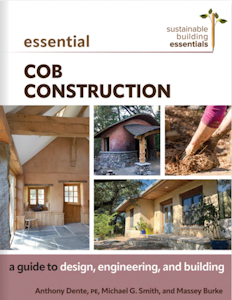
A new cob building book has just been released! CRI Board members Michael G. Smith and Anthony Dente, together with former Board member Massey Burke, have combined decades of cob building and design experience with the most recent research in their new work "Essential Cob Construction: a guide to design, engineering, and building." This book includes and explains the International Building Code cob construction appendix as well as new engineering data and practices.
Topics include:
- Appropriate use of cob in different climates and contexts
- Thermal performance and moisture management
- Structural and architectural design considerations, including fire and earthquake resistance data from extensive laboratory testing
- Hands-on cob construction, including mix design, testing, manual and mechanical mixing, wall building, strong connections with foundations, roofs, and other structural elements, and finishing options
- Building code development and the permitting process for cob
- Planning, budgeting, and quality control
- The complete Cob Construction Appendix of the International Residential Code.
You can order the book from the publisher, New Society Publishing, or on Amazon in both paperback and digital formats.
What is Cob?
Cob is an ancient method of building with earth. Clay-rich soil is mixed with water, straw, and often sand to a dough-like consistency and sculpted into walls while still wet. Under different names, the technique has been common for centuries throughout northern Europe and in parts of Asia, Africa, and the Americas. There are more than 20,000 cob homes in the English county of Devon alone, some of which are as much as 600 years old and still inhabited today.
The Cob Revival
In recent decades cob has enjoyed a revival in North America, Britain, and elsewhere. The resurgence of interest is driven in part by the fact that cob is one of the most ecologically sensible ways to build a house. The materials are often available for low cost or free on or close to the building site. Cob can easily be sculpted into whimsical and curvilinear shapes, making each cob building a unique work of art. Cob walls are highly fire-resistant and contain no harmful chemicals. Despite these advantages, there have been many obstacles to building with cob legally, including an almost total absence of building codes.
Developing the Code
The Cob Research Institute is a 501(c)3 non-profit organization founded in 2008. Our mission is to remove legal obstacles to building with cob while retaining its character as a simple, ecologically sound building system. After many years of intensive collaboration with several universities and testing facilities, as well as dozens of cob builders, engineers, architects, and code specialists, we have produced the world’s first complete model building code for cob. In 2019, our code was approved by voting members of the International Code Council as an appendix to the 2021 International Residential Code.
Next Steps
Despite this enormous victory, much work remains to be done. The code needs to be refined and improved through further laboratory testing and real-world application. A fire-resistance rating needs to be established. Better systems for insulating cob walls must be developed. A great deal of outreach to and education of both building officials and cob builders is required before the code can make its maximum potential impact on the health, safety, and sustainability of building practices at home and around the world. With increasing concerns about the fire safety of our built environment and the contribution of buildings to climate change, our work is more urgent than ever.
Support CRI - Please donate here and join the CRI effort!
CRI's Cob Code Proposal
Approved for the 2021 International Residential Code

